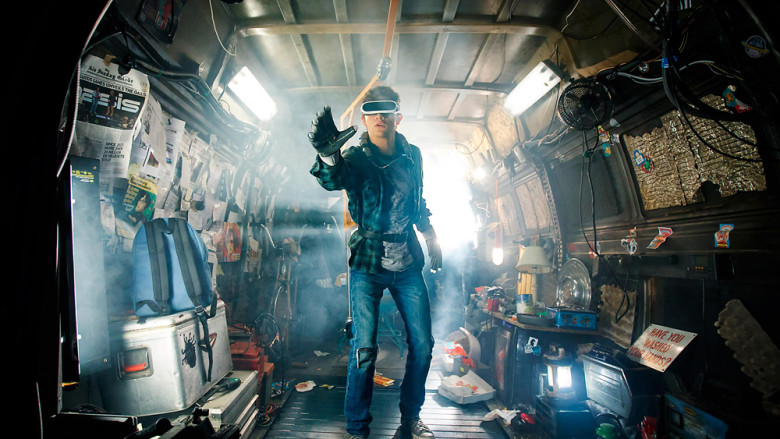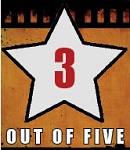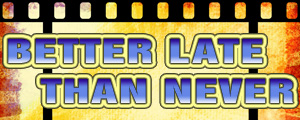

Ready Player One opens with more exposition than any movie in recent memory. Like 10 minutes of it … at least. Through a voice-over, we learn all about the OASIS — the online, fully interactive, virtual 3D world where everyone spends their time in the film's wrecked version of the mid-21st century. Then we're given the life history of James Halliday, the OASIS's brilliant but socially-awkward inventor. Then we're told all about the golden egg that Halliday hid somewhere in the OASIS before his death, the finding of which will result in its discoverer inheriting the OASIS and Halliday's entire empire. Only after all of that do we get finally get a title card and the proper beginning to a movie. It's a lot to take in, though maybe necessary for an adaptation of Ernie Cline's dense and geeky science-fiction yarn that's been both beloved and hated by nerd types since its release in 2011. I fall somewhere between those two camps, as I found Ready Player One the book to offer a pretty fun treasure hunt buried amongst chapter after chapter of god-awful prose. It's also not helped by its corny, one-dimensional characters. Still, the bones were there for a fun theatrical romp, and when Steven Spielberg came on board to direct, no amount of iffy writing seemed insurmountable.
As it turns out, maybe that outlook was too optimistic. Ready Player One the movie successfully excises the cringier elements of the book but also fails to deepen the story past what's on the page, limiting the amount of audience investment it's able to generate. It's a basic and streamlined adaptation — neither offensive nor inspiring — that is competently acted and sometimes excitingly assembled. But it's all very surfacy. You may have something approaching a good time while watching, but the film's pop-culture-fueled imagery is likely to dissipate from your brain by the time you get home from the theater.
The story centers on Wade Watts (Tye Sheridan), an Ohio teenager living in the "stacks" — large columns of trailer homes piled up on top of each other until they a form a sketchily constructed high-rise. (Overpopulation has turned out to be a serious problem in the future.) The crumbling real world offers Watts nothing, so he spends all his time in the OASIS as one of a group of egg hunters, or "gunters," who still look for Halliday's egg years after the rest of the world wrote it off as an impossible challenge. In Cline's novel, there are six parts to this massive quest — three keys that fit three gates, all which must be discovered using a series of riddles that Halliday left behind. Movies being tighter affairs, Spielberg, along with screenwriters Cline and Zak Penn, have cut that number in half, combining each key and gate combination into a single puzzle each. And though the solutions to those puzzles are almost completely changed from the book, they're similar in that they all spring from the minutia of both Halliday's personal life and the films, TV and videogames of 1980s that he was obsessed with as a kid.
Once it's past all that opening exposition, the film jumps to the already-discovered first puzzle: an intense street race that features a colorful variety of vehicles — most pulled from pop-culture sources — trying to avoid King Kong and Jurassic Park's rampaging T-Rex on the way to a finish line that no one has been able to reach without "dying" in the OASIS (which results in you losing your digital gear, your digital coin and pretty much everything else attached to your avatar). Wade, known as "Parzival" in the OASIS, is there in his perfect recreation of Doc Brown's DeLoreon time machine from Back to the Future, and he ends up crossing paths with Art3mis (Olivia Cooke) a famous female gunter driving the motorcycle from Akira. The two are desperately trying to locate Halliday's egg before it's tracked down by IOI, a massive and greedy tech company led by Ben Mendelsohn in full scumbag mode. (IOI is basically every tech company you hate. They want to own the OASIS so they can fill it with pop-up ads, subscription tiers and loot boxes. Ajit Pai will probably root for them when we watches this.)
So this Spielberg guy is a pretty good director, and the race is a blast — especially the second time it's run when Wade figures out the trick to finishing it. Earning the first key puts his name on a scoreboard that's been blank for years, and suddenly the whole world is again invested in the search for Halliday's egg — an adventure that takes Wade and Art3mis (real name: Samantha) through a series of incredible digital locales including a zero-gravity dance club, a massive battlefield littered with more intellectual property than is possible to count, and a jaw-dropping recreation of the [REDACTED] from the classic 80s film [REDACTED]. The movie bounces between the real world, where the good guys group up more quickly than they do in the book, and the OASIS, where we hear the actors' voices springing from fantastical, videogame-like avatars. In the digital world, everyone looks like whatever their character wants to look like. (Assuming the age or even the sex of an OASIS character you haven't yet met in the real world is not a good idea.) By the final act, Spielberg is cross-cutting between three different points of action taking place in two different realities, and it is admittedly thrilling because, duh, Spielberg. But no great theme is ever mined; no point about the infringement of digital space into our daily lives or the increasing overbearingness of pop culture is ever driven home. There's some throwaway stuff about how maybe we should all take the occasional day off from our screens to smell actual roses and kiss the girl, but none of it is earned. Especially since Ready Player One makes no case that the reality of its future America is salvageable to begin with. It's likely the OASIS really is all they got.
The actors are fine for the most part. Sheridan is more charismatic here than he was playing Cyclops in X-Men: Apocalypse. Mendelsohn chews scenery like you expect and want him to. One sour note is current Spielberg muse Mark Rylance, who plays Halliday as the most introverted introvert to ever ignore a sunny day in favor of an Atari 2600 and a living room floor. Rylance so overdoes the awkwardness that the character never feels the least bit real. Some supporting characters, like the anime-loving Sho and Daito, seem to only be included in the film because fans of the book would expect them to be.
The audience cheered at two points during my screening — one involving a seemingly innocuous digital object that ends up saving Wade's ass at a key point (book readers will know it's coming), and another combining the single "fuck" Spielberg was allowed to drop in a PG-13 movie with the star of a middling horror franchise who drops by for a cameo. The latter is such a bizarre bit — at once completely out of place and yet somehow still in tone with this crazy mash-up of a film. Clearly it works for some people. As I'm sure the movie as a whole will too. I was just hoping that Spielberg could offer up something with more texture and depth than what the book offers. Instead, the film is more of a lateral move — a love letter to pop-culture that turns a mirror to the stuff we obsess over without ever making a strong case to itself join those ranks.











